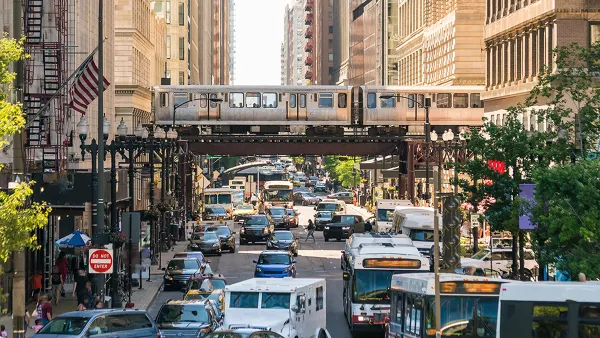According to the Census Bureau's American Community Survey on commuting to work, one subregion in the Bay Area can claim accolades for having achieved the largest drop in solo-commuting from 2006, scoring the third lowest drive-alone rate in 2013.
"Workers in the San Francisco Bay Area made the nation’s most dramatic shift from commuting via automobile to using alternative transportation between 2006 and 2013, according to a new Census Bureau report," writes Dan Walters in a Capitol Alert for The Sacramento Bee on the Census report released Thursday, August 13.
The San Francisco-Oakland-Hayward, CA metropolitan statistical area (MSA) had the third lowest rate of solo commuting in 2012 at 69.8 percent, as listed in Table 2 on page 6 of 28 [PDF] behind:
- New York-Newark-Jersey City, NY-NJ-PA: 56.9%
- Ithaca, NY: 68.7%
Compare those figures with the national drive-alone rate of 76.4 percent. However, the San Francisco MSA achieved the highest rate of decrease of solo auto commuting at 3.8%, listed on Table on page 5, followed by the MSAs of:
- Boston-Cambridge-Newton, MA-NH: 3.3%
- Durham-Chapel Hill, NC: 2.9%
Bicycling was the least popular method of commuting, used by just six-tenths of one percent of workers.
More evidence of peak car?
While the 76.4 percent drive-alone rate in 2013 is high, the press release states that "driving alone to work peaked in 2010 at 76.6 percent.
"In recent years, the percentage of workers who commute by private vehicle remained relatively stable after decades of consistent increase," writes the report's author, Brian Mckenzie, in the introduction. "For several individual years since the mid-2000s, the average number of vehicle miles traveled [VMT] in the United States has either increased at a slower pace than in previous decades or declined."
Although such shifts in travel behavior are slight, they have captured attention because they represent a disruption in an unequivocal, decades-long pattern of increased automobile travel.
Carpooling decline leads to auto commute decline
"Overall, automobile commuting has declined since 2000, in part, due to the continuation of a long-standing pattern of a decline in carpooling," notes McKenzie in a Random Samplings blog" on urban millennial commute choices.
One out of five U.S. workers carpooled in 1980, but in 2013, only one out of 10 carpooled.
McKenzie cites four 2014 research papers from the prolific Michael Sivak of the University of Michigan Transportation Research Institute (UMTRI) that ask, "Has motorization in the U.S. Peaked?"
FULL STORY: SF Bay Area commuters make big shift away from cars

Planetizen Federal Action Tracker
A weekly monitor of how Trump’s orders and actions are impacting planners and planning in America.

Chicago’s Ghost Rails
Just beneath the surface of the modern city lie the remnants of its expansive early 20th-century streetcar system.

Amtrak Cutting Jobs, Funding to High-Speed Rail
The agency plans to cut 10 percent of its workforce and has confirmed it will not fund new high-speed rail projects.

Ohio Forces Data Centers to Prepay for Power
Utilities are calling on states to hold data center operators responsible for new energy demands to prevent leaving consumers on the hook for their bills.

MARTA CEO Steps Down Amid Citizenship Concerns
MARTA’s board announced Thursday that its chief, who is from Canada, is resigning due to questions about his immigration status.

Silicon Valley ‘Bike Superhighway’ Awarded $14M State Grant
A Caltrans grant brings the 10-mile Central Bikeway project connecting Santa Clara and East San Jose closer to fruition.
Urban Design for Planners 1: Software Tools
This six-course series explores essential urban design concepts using open source software and equips planners with the tools they need to participate fully in the urban design process.
Planning for Universal Design
Learn the tools for implementing Universal Design in planning regulations.
Caltrans
City of Fort Worth
Mpact (founded as Rail~Volution)
City of Camden Redevelopment Agency
City of Astoria
City of Portland
City of Laramie





























